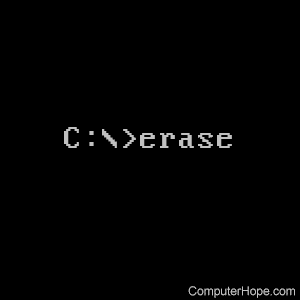Erase command
Updated: 11/12/2023 by Computer Hope

The erase command is used to remove files from your computer's hard drive and other storage devices.
Availability
Erase is an internal command and is available in the following Microsoft operating systems.
- All Versions of MS-DOS
- Windows 95
- Windows 98
- Windows Me
- Windows NT
- Windows 2000
- Windows XP
- Windows Vista
- Windows 7
- Windows 8
- Windows 10
- Windows 11
Erase syntax
Windows command line syntax
DEL [/P] [/F] [/S] [/Q] [/A[[:]attributes]] names ERASE [/P] [/F] [/S] [/Q] [/A[[:]attributes]] names
| names | Specifies a list of one or more files or directories. Wildcards may delete multiple files. If a directory is specified, all files in the directory are deleted. |
| /P | Prompts for confirmation before deleting each file. |
| /F | Force deleting of read-only files. |
| /S | Delete specified files from all subdirectories. |
| /Q | Quiet mode, do not ask if ok to delete on global wildcard. |
| /A | Selects files to delete based on attributes. |
| attributes | R - Read-only files. S - System files. H - Hidden files. A - Files ready for archiving. - Prefix meaning not. |
If Command Extensions are enabled, DEL and ERASE change as follows:
The display semantics of the /S switch are reversed in that it shows you only the files that are deleted, not the ones it could not find.
Early versions of MS-DOS syntax
DEL [drive:][path]file name [/P] ERASE [drive:][path]file name [/P]
| [drive:][path]file name | Specifies the file(s) to delete. Use wildcards to specify multiple files. |
| /P | Prompts for confirmation before deleting each file. |
Erase examples
erase c:\windows\*.tmp
Delete any files that end with the TMP extension (i.e., temporary file).
Tip
You will not receive a confirmation prompt when running this command. Once executed, all files are deleted unless they have a read-only attribute and the /F switch is not being used.
